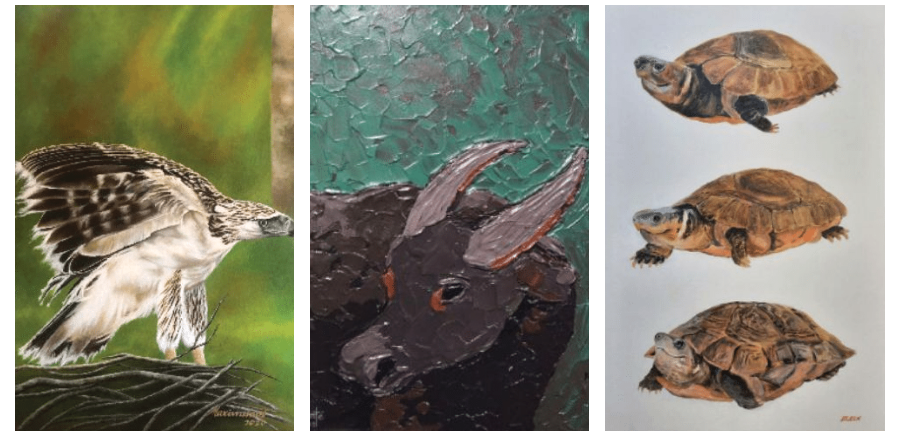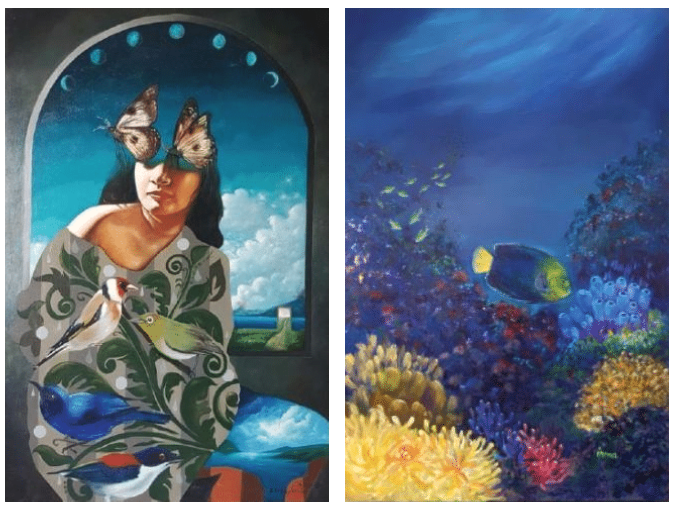by Pao Vergara
With the ubiquity of nature photography and videography, thanks to electronic media, one housewife’s passion is reviving a lost art–while also protecting a bigger future

On an overcast morning at the Conrad Manila, World Nature Conservation Day 2021 saw various sectors and organizations unite to add splashes of color to an otherwise gray week as the venue hosted “Para sa Kalikasan,” an exhibit centered around a seemingly dying craft.
When the phrase “nature documentary” gets mentioned, what often comes to mind is high-definition, 1,080 pixel, 60 frames-per-second shots of swaying savanna grass or lions chasing prey. But before all this, naturalists painstakingly recreated every wing, claw, and fin, branch, stem, and leaf by hand.
Naturally (hehe), the traditional method was relegated in favor of the obviously more efficient choice, where action–data–that was harder to capture before is now quite literally a click away. Of course, this hasn’t necessarily made the job easier, as National Geographic photographers brave extreme weather, terrain, and waiting to get the job done.
And yet, this very ubiquity of audiovisual technology has also brought with it saturation—terms like screen burnout, digital detox, and screen sickness have become buzzwords, what more now, amid a seemingly endless quarantine where the four walls of an LCD screen are quite literally one’s gateway to the world outside, the best substitute so far given an evolving virus.

In response to this, people have taken to more tactile pursuits—you or someone you know is likely a platito or platita, an overnight woodworker, or an aspiring master chef or bartender at this point. All these contexts made for the perfect time for the kick-off of “Para sa Kalikasan.”
Bing Famoso was a housewife who finished an arts course at the University of the Philippines (UP) Manila in 2016 as her kids left the nest. In 2018, as the National Museum of Natural History’s new building was being completed within the National Museum complex, Famoso pitched the idea of reviving fauna and flora painting to the organization’s board.
While they readily approved, time and resources were understandably devoted to the new building’s opening, which eventually became a contemporary icon when it did finally welcome the public. Famoso waited a whole year before the Philippine Fauna Art Society (PFAS) was formally recognized.
She thus took on the task of documenting via painting the country’s endemic species, plants included. “As kids, we were taught to identify lions and giraffes, but not our own species,” says Famoso. Given the Convention on Biological Diversity’s recognition of the Philippines as containing two-thirds of the earth’s biodiversity or around 70 to 80 percent of the world’s plant and animal species, this was—and is—quite the task.
Ever enthusiastic, Famoso made numerous open calls, starting with her immediate networks, for help in this undertaking. This resulted in many exhibits, the latest and to date the largest being “Para sa Kalikasan,” featuring more than 160 works by more than a hundred artists from the Philippines and Malaysia.

A handful of works are displayed as of press time at Conrad Manila’s Gallery C. The rest are in a virtual exhibit currently under construction by the PFAS.
Biodiversity isn’t confined to the Philippines, as many birds and aquatic creatures share migratory routes and nesting areas around Southeast Asia. As such, the PFAS, with backing from the Department of Environment and Natural Resources (DENR) reached out to the Malaysian Art Society, the Penang Art Society, and the Universti Teknologi Mara Faculty of Arts and Design.
Economic development and nature conservation are not an either-or choice. You can have both. —Norman Bin Muhammad, Malaysian ambassador to the Philippines
National borders, after all, are artificial. Norman Bin Muhammad, Malaysian ambassador to the Philippines, notes a shared urgency given both countries’ vulnerability to the effects of human-induced climate change. He recognizes that Malaysia and the Philippines are still developing countries. “Economic development and nature conservation are not an either-or choice. You can have both,” Muhammad says.
The diversity of the project goes beyond the canvas and extends to the artists, too. Ysay Rodriguez took formal training as a painter at UP Diliman, where her critical eye was trained to scrutinize the details in how a work was made.

The open call received submissions from both amateur and professional artists, some of whom were children, scientists, and even gallery regulars, the big names of the scene. Meanwhile, Famoso is gleefully surprised at local masters’ participation.
Now working with the PFAS as a co-curator, Rodriguez has since learned to set her critic lenses aside and view things with a “beginner’s mind,” an experience which she shares is heartening for her, a democratization of art.
Acknowledging screen detox and LCD burnout, Rodriguez shares that the virtual exhibit is designed to be as tactile as possible, not simply presenting images as you scroll endlessly. She shares that many galleries have moved from a “scroll-based” presentation to a 3D remodeling of an actual gallery with the first-person view of someone standing amid the paintings. “You can walk around,” Rodriguez says.
“When many of the artists completed their works, they didn’t expect that they’d be in a virtual exhibit instead of a gallery,” she expounds. “As part of the PFAS support team, it’s my responsibility that a work is experienced in-person gets the best virtual translation.” As a traditional painter, Rodriguez had to teach herself some programming language just for this project.
It’s interesting how an old art form finds new expressions through new technology, all for the sake of community-initiated science communication, the better to raise awareness, versus your standard PSA.
The virtual exhibit is currently under development, follow the Philippine Fauna Art Society on social media for upadtes, or have an artsy lunch date at the Conrad Manila, with yourself or anybody else, all while keeping safe. Philippinefaunaartsociety.cargo.site | +639178614054 | [email protected] | +63288339999
Source: https://mb.com.ph/2021/08/05/how-conserving-an-art-practice-also-conserves-nature/
